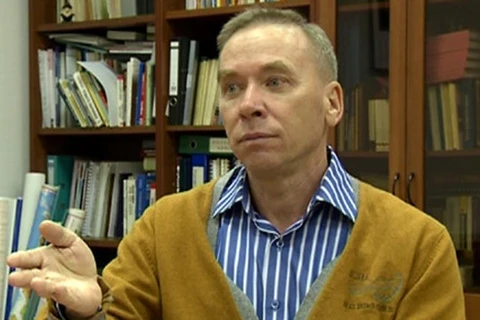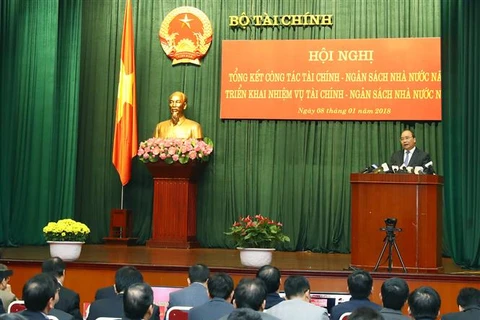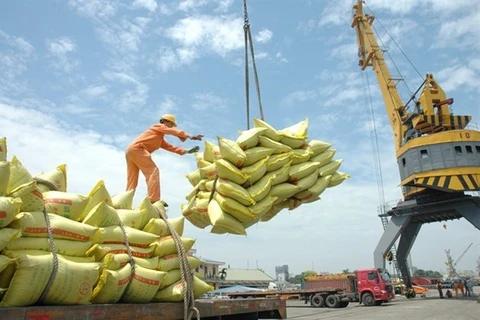
An automatic cotton towel production chain at the Hanosimex’s factory in the Dong Van 2 Industrial Park, northern Ha Nam province. (Photo: VNA)
Hanoi (VNA) - Vietnam experienced a relatively stable macroeconomic situation in 2017, in accordance with general global economic trends, but experts warned there will be obstacles to maintaining such momentum in the turbulent environment of 2018, according to a report by the Vietnam Institute for Economic and Policy Research (VEPR).
Announced at a workshop on January 16 by VEPR Director Nguyen Duc Thanh, the independent assessment report affirmed key 2017 economic successes across sectors, mainly due to increases in exports, investment and domestic consumption.
He forecast that Vietnam’s 2018 economic growth rate will be 6.65 percent. This is within the 2018 targeted range, as passed by the National Assembly (NA), between 6.5 and 6.7 percent.
With current favourable conditions maintained, other NA yearly objectives including an export growth rate from 7 to 8 percent and average consumer price index of 4 percent are also within reach, said Thanh.
Achievements such as the GDP growth rate of 6.81 percent, exceeding the National Assembly’ annual target, improvements in the manufacturing and agriculture sectors and recovery of the service sector were also noted.
Speaking at the event, Truong Dinh Tuyen, former industry and trade minister, attributed such macroeconomic stability to the Government’s determination to enact institutional investment environment reforms.
In the same vein, Le Dang Doanh, former Director of the Central Institute for Economic Management (CIEM), said that contrary to inflation forecasts in 2017’s last quarter, the State Bank of Vietnam’s (SBV) flexible and prudent monetary policy proved to be effective in curbing market prices.
Nonetheless, Doanh warned that the high budget deficit and public debt will continue to seriously hinder the economy. While public investment is still limited, high recurrent expenditures will be a burden on the State budget in 2018, he added.
Prominent economist Vo Tri Thanh commented that monetary policy would continue to be tightened, despite the SBV’s pledges to loosen. Still, stable systematic liquidity facilitates low interbank interest rates.
Meanwhile, economist Nguyen Tri Hieu was convinced that in 2017 the Vietnamese credit sector focused largely on industry and trade, gobbling 78.4 percent out of total credit. This partly explains the impressive growth in the manufacturing sector as well as in the service sector.
However, he was worried that as the country’s 2017 credit-to-GDP rate was around 135 percent, higher than other countries with similar levels of development and approaching previous instability levels. He said this could lead to the disruption of the banking system’s financial balance.
Despite positive signs, there remain potential challenges associated with macroeconomic instability in 2018, as many internal and external economic problems have yet to be thoroughly resolved, admitted Thanh.
Economic problems that will remain dead-weight burdens to growth include low labour productivity, diminishing advantage of cheap labour due to the 4.0 industrial revolution’s impact, declining mining output, stagnation in the manufacturing and agricultural sector, increasing budget deficits and public debt.
Dependence on the world economy and the foreign invested sector also creates many major uncertainties for Vietnam in 2018, relating to geopolitical developments and trade protectionism as well as rapid global technology changes, Thanh concluded.
As such, Tuyen suggested that as the country stops being eligible for official development aid, foreign donors would gradually withdraw and only provide loans at preferential interest rates. Vietnam would need to utilise internal resources as a motivation for growth.
The Government should take drastic and comprehensive policy measures to tighten recurrent expenditures and improve labour productivity in the context of the current demographic dividend, to sustain the current growth momentum, said Tuyen.
Since 2014, the VEPR’s macroeconomic reports have been published quarterly and annually with support from the Konrad-Adenauer Stiftung (KAS) to discuss trending economic issues and propose potential solutions.-VNA
VNA
























